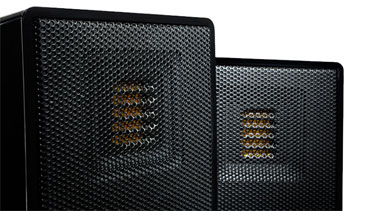Test Report: Martin Logan Motion Series Speakers Page 3

PERFORMANCE
With the speakers thus deployed, I began to hear what MartinLogan's Motions were all about - especially as I became accustomed to a sound distinctly different from the median of what's typically heard from more conventional designs. Listening at first only to full-range stereo music via the Motion 12s, I was struck by a decided air of depth and resonance. For example, on the Howlin' Wolf classic "Howlin' for My Darling," from Jimmie Rodgers's Blue Bird CD (a JVC audiophile-label edition), the front-to-back dimension was dramatically greater with the Motion 12s than via either of my everyday compact monitor pairs. Particularly with harp (harmonica) soloing and hi-hat cymbal patterns, I heard stage-depth and room ambience that on the other speakers (both excellent designs) were far less evident. Though these elements were still there in due proportion, I had to listen for them more actively.
Orchestral strings brought out the very best from the MartinLogan towers. A 96/24 HDTracks download of the Pulcinella Suite - Stravinsky's delightful neoclassical re-imagining of music believed at the time to have been written by the 18th-century Italian Pergolesi (whose 300th birthday falls this year) - fairly tingled with live, in-hall woodiness and rosin-on-strings bite. String attacks were excitingly lifelike, and hall sound fairly bloomed around the speakers.
Vocals likewise pleased with a dramatic presence and great breath and articulation detail. That said, the Motion 12's tonal delivery of typical male vocals was also a bit different-sounding: not exactly hollow or "cupped" but a bit woodier, or perhaps drier in timbre than either of my long-term speakers. If I were forced to guess, I'd attribute this to the unusual midrange enclosure; in fact, when I compared the Motion 12 with the Motion 4, whose enclosure is more or less conventionally vented via a single tuned port, I heard a closer match between the 4 and both my touchstone pairs. (Indeed, the 4 proved to be an impressive little shelver in its own right.).
The Motion 12s' bass extension was adequate. Typical pop bass had satisfying heft and impact, but there was also just a hint of a woody, almost thuddy character with certain recordings. I did find that pulling the towers even farther out into the room softened this quality - but in my room, like most others, this arrangement wasn't very practical. (Something analogous was true of the towers' upper, "dipole" midrange cabinet, the sound of which colored audibly when placed closer than about 2 feet to any reflective surface.)
- Log in or register to post comments




















































